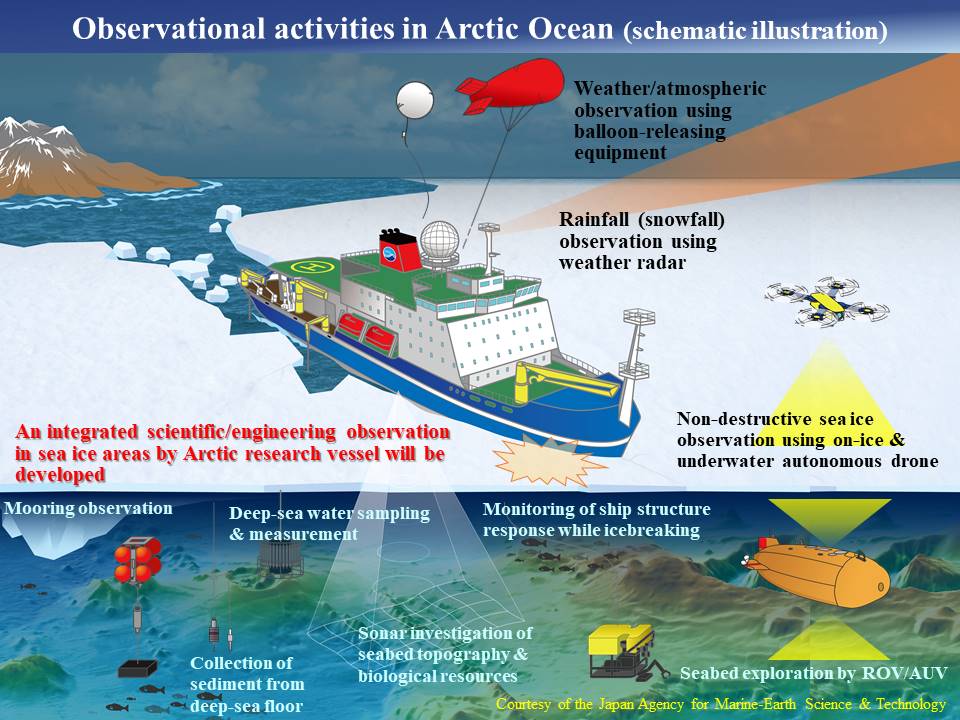Construction of New Arctic Research Vessel with Icebreaking Capacity Decided
Hajime Yamaguchi
Graduate School of Frontier Sciences
The University of Tokyo
Late in December 2020, a government budget for fiscal 2021 was approved by a Cabinet decision, effectively giving the green light to the construction of a new Arctic research vessel with icebreaking capability. It is supposed to take around five years to build the ship. At present, the oceanographic research vessel “MIRAI” of the Japan Agency for Marine-Earth Science and Technology (JAMSTEC) has accomplished many leading-edge achievements by conducting an observational voyage every summer. Not being an icebreaker, however, the vessel cannot enter sea ice areas. As the new Arctic research vessel is scheduled to be capable of continuously breaking level ice up to 1.2 meters thick, it will be able to carry out sea ice observation and many other new observational activities (Table 1, Figure 1).
| Planned principal articulars of the Arctic research vessel (in parentheses are MIRAI’s equivalents) |
|
|---|---|
| Length – Overall | 128m(128.5m) |
| Beam | 23m(19m) |
| Depth | 12.4m(10.5m) |
| Draft | 8m(6.9m) |
| Int’l gross tonnage | 13,000 tons (8,706 tons) |
| Icebreaking capacity | 1.2m,3.0kt(–) |
| Ice class | PC4 (PC7) |
| Accommodation | 99(80) |
Courtesy of the Japan Agency for Marine-Earth Science & Technology
The new ship’s ice class will be equivalent to PC4 , which can navigate through thick first-year ice in the Arctic Ocean all year round. She will be able to continuously break level ice up to 1.2 meters thick. The “MIRAI,” on the other hand, cannot enter sea ice areas as it is without icebreaking capability.

The new vessel is to be completed in the second year of the next round of Arctic research project following the ArCS II. However, bearing the new Arctic research ship in mind, research undertaken in the current ArCS II period should be undertaken in a manner that can be applied at a later time in order to lay the groundwork to achieve study results soon after completion of the new ship. The vessel is scheduled to be so designed as to take into account an international research platform, diversity and environmental preservation. Described below are the main characteristics of the new ship being examined by JAMSTEC.
- Equipped not only with observational equipments enabling MIRAI-level meteorological and oceanographic observations, but also with scientific fish sonar and other new equipments not aboard the MIRAI
- Hull form enabling both necessary and sufficient icebreaking/ice-resistant ability in sea ice areas, and observational performance in normal ocean areas as well
- Equipped with “ice navigation support system” for safe and efficient navigation through Arctic sea ice areas
- Ingenuity to reduce environmental load and improve fuel economy by adopting a dual-fuel system (combining fuel oil and LNG), the world’s first for a research vessel
- Equipped with dynamic positioning capability for conducting activities in stable manner such as operation of unmanned vehicles and water sampling, and with effective propulsion system
- Equipped with submersibles such as remotely operated vehicles (ROVs) and autonomous underwater vehicles (AUVs)
- Capable of operating helicopter for ensuring safety, observing sea ice, etc.
- Complete with a world-class research and analysis environment, such as sufficient laboratory space and excellent networking
- Realization of a universal living environment as the international platform
- Responsive to needs for rescue/support in areas affected by downpours and other natural disasters
As shown by establishing a working group on an Arctic research ship utilization plan set up inside the Japan Consortium for Arctic Environmental Research (JCAR) , an organization effectively promoting and coordinating Arctic research in Japan, we expect to listen to requests from a community of Arctic researchers for the planned new vessel so that we will be able to achieve the highest level of research results.